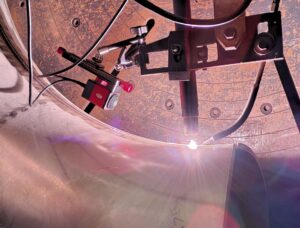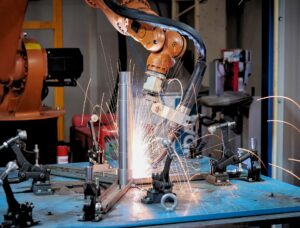In this blog, we’ll examine automotive welding quality control and how advanced monitoring systems are helping manufacturers meet stringent safety standards while maintaining high-volume production efficiency. The automotive industry operates under some of the most stringent quality requirements in manufacturing, where welding defects can compromise passenger safety and result in costly recalls. Advanced weld monitoring systems are becoming essential tools for meeting these demanding standards while maintaining the high production volumes and cost efficiency required in automotive manufacturing.
The Critical Nature of Automotive Welding
Automotive welding quality control directly impacts vehicle safety and performance:
Structural Integrity: Body-in-white welds must withstand crash forces and provide occupant protection.
Safety Systems: Critical components like seat belt anchors and airbag housings require perfect welds.
Durability Requirements: Automotive welds must maintain strength over vehicle lifetimes exceeding 200,000 miles.
Regulatory Compliance: Multiple safety standards and regulations govern automotive welding quality.
Automotive Welding Applications
The automotive industry encompasses diverse welding applications, each with specific monitoring requirements:
Body-in-White Assembly: High-volume resistance spot welding and laser welding of body panels requiring consistent quality across thousands of welds per vehicle.
Powertrain Components: Critical engine and transmission components where weld failure can cause catastrophic mechanical failure.
Suspension Systems: Structural welds that must withstand dynamic loading and fatigue over extended service life.
Exhaust Systems: Welds exposed to high temperatures and corrosive environments requiring excellent corrosion resistance.
Battery Enclosures: Electric vehicle battery packs requiring hermetic sealing and structural integrity for safety.
Safety Standards and Regulations
Automotive welding must comply with numerous standards:
ISO 26262 (Functional Safety): Requirements for safety-critical automotive systems including welding quality assurance.
FMVSS (Federal Motor Vehicle Safety Standards): US regulations governing vehicle safety performance.
ECE Regulations: European standards for vehicle safety and performance.
IATF 16949: Automotive quality management system requirements including welding process control.
OEM Specifications: Manufacturer-specific requirements that often exceed industry standards.
Advanced Monitoring Technologies
Modern automotive welding monitoring employs sophisticated technologies:
Real-Time Resistance Monitoring: Continuous measurement of electrical resistance during spot welding to ensure proper nugget formation.
Laser Weld Monitoring: High-speed cameras and photodiodes that monitor keyhole stability and weld pool characteristics.
Ultrasonic Weld Monitoring: Real-time monitoring of plastic welding processes used in interior and exterior components.
Vision Systems: AI-powered cameras that inspect weld appearance, geometry, and surface quality.
Force and Displacement Monitoring: Precise measurement of electrode force and displacement in resistance welding applications.
Spot Welding Quality Control
Spot welding represents the largest volume of automotive welds, requiring specialized monitoring:
Nugget Formation Monitoring: Real-time assessment of weld nugget development through electrical parameter analysis.
Electrode Condition Monitoring: Tracking of electrode wear and contamination that affects weld quality.
Expulsion Detection: Identification of metal expulsion that indicates excessive heat input.
Shunt Current Monitoring: Detection of current paths that bypass the intended weld location.
Laser Welding Monitoring
Automotive laser welding requires different monitoring approaches:
Keyhole Monitoring: Direct observation of keyhole formation and stability for deep penetration welds.
Seam Tracking: Real-time adjustment of beam position to follow joint geometry variations.
Power Monitoring: Continuous monitoring of laser power and beam quality.
Spatter Detection: Identification of excessive spatter that indicates process instability.
High-Volume Production Considerations
Automotive manufacturing’s high-volume requirements create unique monitoring challenges:
Cycle Time Constraints: Monitoring systems must operate within tight cycle time requirements, often less than 30 seconds per vehicle.
Multi-Station Coordination: Coordination of monitoring across multiple welding stations and production lines.
Data Management: Handling massive volumes of quality data from thousands of welds per day.
Statistical Process Control: Real-time SPC analysis to detect process drift before it affects quality.
Integration with Manufacturing Systems
Automotive monitoring systems integrate with existing manufacturing infrastructure:
PLC Integration: Direct communication with programmable logic controllers for real-time process control.
MES Connectivity: Integration with manufacturing execution systems for production tracking and quality documentation.
Database Systems: Automatic storage of quality data in enterprise databases for analysis and reporting.
Plant Networks: Secure communication across plant networks for centralized monitoring and control.
Case Study: Electric Vehicle Battery Pack Manufacturing
A leading EV manufacturer implemented comprehensive welding monitoring for battery pack assembly:
Challenge: Battery pack welding failures could cause fires or explosions, making quality control critical for safety.
Solution: Integrated monitoring system combining laser weld monitoring, thermal imaging, and automated leak testing.
Results
- Zero field failures related to weld defects
- 50% reduction in quality inspection time
- 30% improvement in production throughput
- Complete traceability for every weld in every battery pack
Defect Prevention Strategies
Advanced monitoring enables proactive defect prevention:
Predictive Maintenance: Early detection of equipment problems before they affect weld quality.
Parameter Optimization: Continuous optimization of welding parameters based on real-time quality feedback.
Process Standardization: Consistent monitoring ensures uniform quality across multiple production facilities.
Operator Training: Real-time feedback helps operators maintain optimal welding technique.
Quality Documentation and Traceability
Automotive applications require comprehensive quality documentation:
Weld Genealogy: Complete traceability from raw materials through finished vehicle.
Statistical Reports: Automated generation of quality reports for customer and regulatory requirements.
Trend Analysis: Long-term analysis of quality trends to identify improvement opportunities.
Recall Support: Detailed quality records to support investigation of field issues or recalls.
Cost-Benefit Analysis
The ROI of automotive welding monitoring includes:
Direct Savings:
- Reduced scrap and rework costs
- Decreased warranty claims
- Lower inspection labor costs
- Improved production efficiency
Risk Mitigation:
- Reduced recall risk
- Improved brand reputation
- Enhanced customer satisfaction
- Regulatory compliance assurance
Emerging Technologies
Several emerging technologies promise to enhance automotive welding monitoring:
Artificial Intelligence: Machine learning algorithms that continuously improve defect detection and process optimization.
Digital Twins: Virtual models that predict weld quality and optimize process parameters.
Augmented Reality: AR systems that overlay quality data onto operator workstations.
Blockchain: Immutable quality records that enhance traceability and prevent fraud.
Implementation Strategies
Successful automotive monitoring implementation requires:
Pilot Programs: Starting with critical applications to prove value before full deployment.
Change Management: Structured approach to managing organizational change and operator training.
Vendor Partnerships: Close collaboration with monitoring system suppliers who understand automotive requirements.
Continuous Improvement: Regular review and optimization of monitoring systems based on production experience.
Future Outlook
The future of automotive welding monitoring includes:
Autonomous Quality Control: Systems that automatically adjust welding parameters to maintain optimal quality.
Predictive Quality: AI systems that predict quality issues before they occur.
Integrated Supply Chain: Quality data that flows seamlessly from suppliers through final assembly.
Smart Factories: Fully integrated manufacturing systems where welding monitoring is part of comprehensive production optimization.
Conclusion: Automotive Welding Quality Control
Advanced welding monitoring has become essential for automotive manufacturers seeking to meet stringent safety standards while maintaining competitive production costs. The technology not only ensures current quality requirements but also positions manufacturers for future challenges as vehicles become more complex and safety standards continue to evolve.
The investment in monitoring technology represents not just a quality improvement but a strategic advantage in an industry where reputation and safety are paramount. As the automotive industry continues its transformation toward electric and autonomous vehicles, the role of advanced welding monitoring will only become more critical.
Success in automotive manufacturing increasingly depends on the ability to prevent weld defects rather than detect them, making real-time monitoring an essential capability for any manufacturer serious about long-term success in this demanding industry.
Looking to improve your welding workflow? Mecaweld offers advanced welding camera systems that help you visualize, inspect, and refine every weld. Contact us to learn how we can help you take control of weld quality in stainless steel projects.



